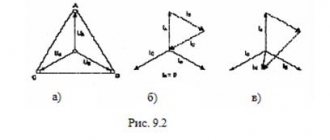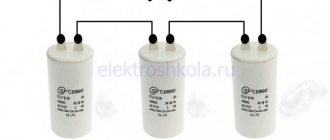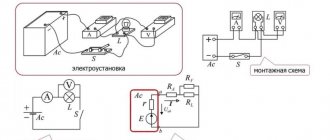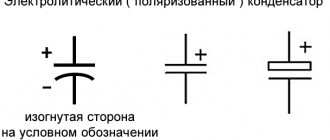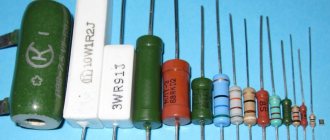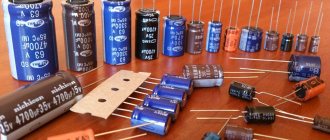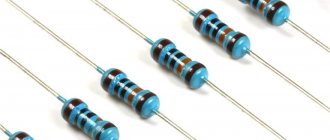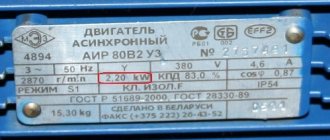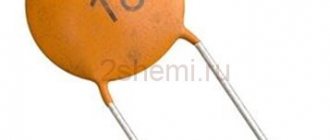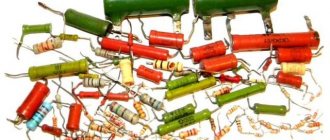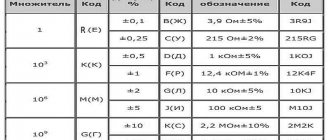The values of commercially produced electronic components (resistor values, capacitor values, inductance of small inductors) are not arbitrary. There are special series of denominations established by the standard,[1] representing sets of values from 1 to 10. The denomination of a part of a certain series is some value from the corresponding series, multiplied by an arbitrary decimal factor (10 to the integer power). For example: resistor from the E12
may have one of the following ratings (resistances):
- 1,2
- 12 ohm
- 120 Ohm
- …
- 1.2 MOhm
- 12 MOhm
Nominal series E6, E12 and E24
The name of the series indicates the total number of elements in it, that is, series E24 contains 24 numbers in the range from 1 to 10, E12 - 12 numbers, etc.
Each row corresponds to a certain tolerance in the part ratings. Thus, parts from the E6 series have a permissible deviation from the nominal value of ±20%, from the E12 series - ±10%, from the E24 series - ±5%. Actually, the rows are arranged in such a way that the next value differs from the previous one by slightly less than double tolerance.
The nominal values for some rows are given in the table:
Nominal rows E3, E6, E12, E24
| E3 | E6 | E12 | E24 | E3 | E6 | E12 | E24 | E3 | E6 | E12 | E24 | ||
| 1,0 | 1,0 | 1,0 | 1,0 | 2,2 | 2,2 | 2,2 | 2,2 | 4,7 | 4,7 | 4,7 | 4,7 | ||
| 1,1 | 2,4 | 5,1 | |||||||||||
| 1,2 | 1,2 | 2,7 | 2,7 | 5,6 | 5,6 | ||||||||
| 1,3 | 3,0 | 6,2 | |||||||||||
| 1,5 | 1,5 | 1,5 | 3,3 | 3,3 | 3,3 | 6,8 | 6,8 | 6,8 | |||||
| 1,6 | 3,6 | 7,5 | |||||||||||
| 1,8 | 1,8 | 3,9 | 3,9 | 8,2 | 8,2 | ||||||||
| 2,0 | 4,3 | 9,1 |
It can be seen that the E12 series is obtained by deleting every second denomination from the E24 series, similarly, E6 is obtained by deleting every second denomination from E12.
What it is
A number of ratings are typical values of the nominal values of radio-electronic components. In addition to the size, they also determine the permissible deviations for this group of parts. Standardization of resistance, capacitance and inductance values for industrially produced products is necessary to ensure compliance with products manufactured in different countries.
A number of denominations are designated by the Latin letter E and numbers. The numbers reflect the number of nominal resistance values of resistors, capacitor capacitance or inductance of coils in it. For example, E3 has 3 values, and E24 has 24 values, respectively.
The letter E means it meets EIA (Electronic Industries Alliance) standards.
The standardization process began back in 1948 at the Technical Committee No. 12 “Radio Communications”, when denomination values close to E12 were given. And already in 1950 E6, E12, E24 were developed. As a result, only 7 series of standard values and tolerances for deviations (errors) from them were adopted. What is it for?
Let’s say there is a number “1.0” in E6, which means that all resistors must have a resistance in fractions of this number (if divided) or multiplied by 10n. For example:
1,0*102=100
This means there could be a 100 ohm resistor. The next number in the set is “1.5”. That is, there is no 120 Ohm element in the E6 set of values, maybe already 150 Ohms. Why was this done?
As we have already mentioned, certain tolerances are attached to each row, for E6 this is ±20%, which means that the resistance of the “100 Ohm” resistor in this case can be from 80 to 120 Ohms. To “separate” these values further from each other, a certain step was chosen.
The step is also not chosen arbitrarily; the set of denominations is a table of decimal logarithms; the value of any member of the series can be calculated using the formula:
where n is the member number, and N is the row number (E3, E6, etc.).
Let's look at this issue in more detail.
Principles of constructing series
The series E24 is approximately a geometric progression with a denominator of 101/24. In other words, on a logarithmic scale, the elements of this series divide the segment from 1 to 10 into 24 equal parts. For some apparently historical reasons, some elements differ from the ideal progression, although never by more than 5%. Nominal series with fewer elements are obtained by deleting elements from the E24 series one by one. The denominations from these series form an approximately geometric progression with the denominator 101/12 (E12), 101/6 (E6), 101/3 (E3). The E3 series is practically not used. Nominal series with a large number of elements form an absolutely exact geometric progression with a denominator of 101/ n
, where
n
is the number of elements of the series.
The number n
is always a power of 2 times 3.
The nominal series is essentially a table of decimal logarithms. Indeed, the ordinal number of the element in the series minus 1 gives the mantissa of the logarithm in the form of a simple fraction with a denominator ( m
− 1)/
n
(
m
is the number of the element,
n
is the order of the row, for example, 24 for E24). Knowing the series E24 by heart, you can thus mentally calculate products of numbers, roots of small powers of numbers, logarithms of numbers with an accuracy of approximately ±5%. For example, let's calculate the square root of 1000. The decimal logarithm of this number is 3, dividing it in half, we find that the decimal logarithm of the answer is 1.5 = 1 + 12/24, i.e. the answer is 10 times the element in the row E24 in 13th place, i.e. exactly in the middle of the row, i.e. we got about 33.
There is a universal way to determine the denomination for any series:
V(n) = 10^{n/N} = \exp \left( \frac{n}{N} \cdot \ln 10 \right),
where N is the row number (3, 6, 12, 24, etc.), and n = 0, 1, 2, …, (n) means the serial number of the denomination in the row.[2].
Tables of denominations
Let us immediately note that the numbers from all rows are the same for capacitors, resistors, and chokes. But there are some peculiarities. Let’s say right away that the most common are:
- E3 (currently almost not used, but you can find old elements corresponding to it);
- E6;
- E12;
- E24;
As we have already said, the permissible deviation from the specified rating also depends on the number of ratings to which the electronic component belongs. You can see the table of permissible deviations below:
| Row | Tolerance |
| E3 | ±50% |
| E6 | ±20% |
| E12 | ±10% |
| E24 | ±5% |
| E48 | ±2% |
| E96 | ±1% |
| E192 | ±0.5%, 0.25%, 0.1% and more accurately |
It turns out that the error of elements corresponding to the values from E3 can differ by half in both directions, while for the common E24 it is only 5 percent. Let's look at typical values.
For resistors
On the market you can find resistances from all existing series, except that E3 is not found in new components. The table below shows the values for groups E3, E6, E12, E24, the last three being the most common.
We also present values from the series of denominations E48, E96, E192.
Beginners often ask: “How to use these numbers?”
It's quite simple. Let's imagine you were calculating a resistor for some circuit. As a result, it turned out that an element with a resistance of 1170 Ohms was needed.
After analyzing which ones could be bought at the nearest store, we decided that we needed to choose from the volume of E24 values and saw that there were numbers 1.1 and 1.2. These numbers need to be multiplied or divided by 10 so many times to get a value that is close to your calculations, for example:
1.1*10*10*10=1100 Ohm
1.2*10*10*10=1200 Ohm
Here 1200 ohms or 1.2 kohms is closer to 1170 ohms than 1.1 kohms. This means you have already selected the appropriate value from a range of E24 denominations. This way you can match the calculated resistor to the real one, which you can find on sale or in your stash.
For capacitors and inductors
The situation is similar with the capacitance of permanent capacitors. But most often found on sale are elements from the series E3, E6, E12, E24, and less often E48, E96 and E192. This is due to the fact that capacitors with tighter tolerances are difficult to manufacture.
The method of using the above tables is similar. For example, below we will place a table with the code designation and nominal capacitance of capacitors from E3 and E6 in pico-nano- and microfarads.
Inductors or, as they are also called, chokes are produced by manufacturers according to the same rules - inductance most often corresponds to the values from E12 or E24.
It is worth noting that most electronic circuits do not require high precision in the selection of radio-electronic components and a deviation of 5 or even 10% is considered quite acceptable. Moreover, having purchased several identical parts, you can measure their real resistance, inductance or capacitance and select those closest to the calculated ones. Also take into account the operating features of the device, for example, how the values of the elements change at different temperatures. That's all we wanted to tell you about what types of ratings there are for radio components.
Nominal series with a large number of elements
The E48 series corresponds to a relative accuracy of ±2%, E96 - ±1%, E192 - ±0.5%.
The elements of these series form a geometric progression with denominators 101/48 ≈ 1.04914, 101/96 ≈ 1.024275, 101/192 ≈ 1.01206483 and can be calculated on a calculator. Nominal series E48, E96, E192
| E48 | E96 | E192 | E48 | E96 | E192 | E48 | E96 | E192 | E48 | E96 | E192 | E48 | E96 | E192 | E48 | E96 | E192 | |||||
| 1,00 | 1,00 | 1,00 | 1,47 | 1,47 | 1,47 | 2,15 | 2,15 | 2,15 | 3,16 | 3,16 | 3,16 | 4,64 | 4,64 | 4,64 | 6,81 | 6,81 | 6,81 | |||||
| 1,01 | 1,49 | 2,18 | 3,20 | 4,70 | 6,90 | |||||||||||||||||
| 1,02 | 1,02 | 1,50 | 1,50 | 2,21 | 2,21 | 3,24 | 3,24 | 4,75 | 4,75 | 6,98 | 6,98 | |||||||||||
| 1,04 | 1,52 | 2,23 | 3,28 | 4,81 | 7,06 | |||||||||||||||||
| 1,05 | 1,05 | 1,05 | 1,54 | 1,54 | 1,54 | 2,26 | 2,26 | 2,26 | 3,32 | 3,32 | 3,32 | 4,87 | 4,87 | 4,87 | 7,15 | 7,15 | 7,15 | |||||
| 1,06 | 1,56 | 2,29 | 3,36 | 4,93 | 7,23 | |||||||||||||||||
| 1,07 | 1,07 | 1,58 | 1,58 | 2,32 | 2,32 | 3,40 | 3,40 | 4,99 | 4,99 | 7,32 | 7,32 | |||||||||||
| 1,09 | 1,60 | 2,34 | 3,44 | 5,05 | 7,41 | |||||||||||||||||
| 1,10 | 1,10 | 1,10 | 1,62 | 1,62 | 1,62 | 2,37 | 2,37 | 2,37 | 3,48 | 3,48 | 3,48 | 5,11 | 5,11 | 5,11 | 7,50 | 7,50 | 7,50 | |||||
| 1,11 | 1,64 | 2,40 | 3,52 | 5,17 | 7,59 | |||||||||||||||||
| 1,13 | 1,13 | 1,65 | 1,65 | 2,43 | 2,43 | 3,57 | 3,57 | 5,23 | 5,23 | 7,68 | 7,68 | |||||||||||
| 1,14 | 1,67 | 2,46 | 3,61 | 5,30 | 7,77 | |||||||||||||||||
| 1,15 | 1,15 | 1,15 | 1,69 | 1,69 | 1,69 | 2,49 | 2,49 | 2,49 | 3,65 | 3,65 | 3,65 | 5,36 | 5,36 | 5,36 | 7,87 | 7,87 | 7,87 | |||||
| 1,17 | 1,72 | 2,52 | 3,70 | 5,42 | 7,96 | |||||||||||||||||
| 1,18 | 1,18 | 1,74 | 1,74 | 2,55 | 2,55 | 3,74 | 3,74 | 5,49 | 5,49 | 8,06 | 8,06 | |||||||||||
| 1,20 | 1,76 | 2,58 | 3,79 | 5,56 | 8,16 | |||||||||||||||||
| 1,21 | 1,21 | 1,21 | 1,78 | 1,78 | 1,78 | 2,61 | 2,61 | 2,61 | 3,83 | 3,83 | 3,83 | 5,62 | 5,62 | 5,62 | 8,25 | 8,25 | 8,25 | |||||
| 1,23 | 1,80 | 2,64 | 3,88 | 5,69 | 8,35 | |||||||||||||||||
| 1,24 | 1,24 | 1,82 | 1,82 | 2,67 | 2,67 | 3,92 | 3,92 | 5,76 | 5,76 | 8,45 | 8,45 | |||||||||||
| 1,26 | 1,84 | 2,71 | 3,97 | 5,83 | 8,56 | |||||||||||||||||
| 1,27 | 1,27 | 1,27 | 1,87 | 1,87 | 1,87 | 2,74 | 2,74 | 2,74 | 4,02 | 4,02 | 4,02 | 5,90 | 5,90 | 5,90 | 8,66 | 8,66 | 8,66 | |||||
| 1,29 | 1,89 | 2,77 | 4,07 | 5,97 | 8,76 | |||||||||||||||||
| 1,30 | 1,30 | 1,91 | 1,91 | 2,80 | 2,80 | 4,12 | 4,12 | 6,04 | 6,04 | 8,87 | 8,87 | |||||||||||
| 1,32 | 1,93 | 2,84 | 4,17 | 6,12 | 8,98 | |||||||||||||||||
| 1,33 | 1,33 | 1,33 | 1,96 | 1,96 | 1,96 | 2,87 | 2,87 | 2,87 | 4,22 | 4,22 | 4,22 | 6,19 | 6,19 | 6,19 | 9,09 | 9,09 | 9,09 | |||||
| 1,35 | 1,98 | 2,91 | 4,27 | 6,26 | 9,20 | |||||||||||||||||
| 1,37 | 1,37 | 2,00 | 2,00 | 2,94 | 2,94 | 4,32 | 4,32 | 6,34 | 6,34 | 9,31 | 9,31 | |||||||||||
| 1,38 | 2,03 | 2,98 | 4,37 | 6,42 | 9,42 | |||||||||||||||||
| 1,40 | 1,40 | 1,40 | 2,05 | 2,05 | 2,05 | 3,01 | 3,01 | 3,01 | 4,42 | 4,42 | 4,42 | 6,49 | 6,49 | 6,49 | 9,53 | 9,53 | 9,53 | |||||
| 1,42 | 2,08 | 3,05 | 4,48 | 6,57 | 9,65 | |||||||||||||||||
| 1,43 | 1,43 | 2,10 | 2,10 | 3,09 | 3,09 | 4,53 | 4,53 | 6,65 | 6,65 | 9,76 | 9,76 | |||||||||||
| 1,45 | 2,13 | 3,12 | 4,59 | 6,73 | 9,88 |
Standard series of denominations used in electronics
The ratings of industrially produced radio components (resistance of resistors, capacitance of capacitors, inductance of inductors) are not arbitrary. There are special standardized series of denominations, the so-called E-series, which are sets of values from 1 to 10 (see table below). The denomination of a part of a certain series is an arbitrary value from the corresponding set E, multiplied by an arbitrary decimal factor (10 to the integer power).
This system appeared at the beginning of the 20th century, when most resistors were carbon-graphite with relatively low accuracy. The rationale was simple—component ratings should be chosen based on the precision with which they can be produced. For example, taking a reference value of 100 ohms and with a manufacturing accuracy of 10%, it would not make sense to produce a resistor with a nominal value of 105 ohms, since it would fall within the 10% accuracy range of a 100 ohm resistor. The next acceptable value would be 120 ohms, since a 100 ohm resistor is assumed with 10% accuracy to have a value value somewhere between 90 and 110 ohms, and a 120 ohm resistor to have a value value between 110 and 130 ohms. Following this logic, the recommended values for resistors with 10% accuracy between 100 and 1000 ohm values would be 100, 120, 150, 180, 220, 270, 330, 390, 470, 560, 680, 820. Such a range of values with 10% accuracy called E12. The number after the letter E indicates the number of denominations in each decimal interval.
E-series define ratings for different precision values. The following E series are used in modern industry:
- E6 - 20% accuracy
- E12 - 10% accuracy
- E24 - 5% accuracy
- E48 - 2% accuracy
- E96 - 1% accuracy
- E192 - accuracy 0.5%, 0.25%, 0.1% and higher.
Using E-Ranges when designing electronic devices is the best way to ensure that this rating will always be available in suppliers' warehouses and will be widely used throughout the world. For example, the E48 series is almost always supported by stock companies for resistors with 1% accuracy. However, this inventory management practice leaves large gaps (holes) between adjacent denominations that are not covered by the specified 1% accuracy (after all, the E48 range is designed to cover the entire range of denominations at 2% accuracy). However, having denominations from the E48 1% series in stock, you can quite easily close the existing symmetrical gaps in the denominations by purchasing the missing components, but from the E96 series, because all the denominations of the E48 series are repeated in the E96 series.
The same logic cannot be applied to the E24 series, which contains denominations that are not present in the higher series. But many manufacturers still produce components with E24 series ratings within 1% accuracy, even though they have negligible differences with higher series ratings (compare, for example, 1.20 ohms 1% for E24 series and 1. 21 Ohm 1% according to series E48, etc.). Such denominations from the E24 series with an accuracy of 1% leave larger and more asymmetrical gaps in the value series. Therefore, the use of the E48 series for 1% accuracy is more preferable for inventory management in warehouse companies.
| E6 | E12 | E24 | E48 | E96 | E192 |
| 1,00 | 1,00 | 1,00 | 1,00 | 1,00 | 1,00 |
| 1,01 | |||||
| 1,02 | 1,02 | ||||
| 1,04 | |||||
| 1,05 | 1,05 | 1,05 | |||
| 1,06 | |||||
| 1,07 | 1,07 | ||||
| 1,09 | |||||
| 1,10 | 1,10 | 1,10 | 1,10 | ||
| 1,11 | |||||
| 1,13 | 1,13 | ||||
| 1,14 | |||||
| 1,15 | 1,15 | 1,15 | |||
| 1,17 | |||||
| 1,18 | 1,18 | ||||
| 1,20 | |||||
| 1,20 | 1,20 | 1,21 | 1,21 | 1,21 | |
| 1,23 | |||||
| 1,24 | 1,24 | ||||
| 1,26 | |||||
| 1,27 | 1,27 | 1,27 | |||
| 1,29 | |||||
| 1,30 | 1,30 | ||||
| 1,32 | |||||
| 1,30 | 1,33 | 1,33 | 1,33 | ||
| 1,35 | |||||
| 1,37 | 1,37 | ||||
| 1,38 | |||||
| 1,40 | 1,40 | 1,40 | |||
| 1,42 | |||||
| 1,43 | 1,43 | ||||
| 1,45 | |||||
| 1,50 | 1,50 | 1,50 | 1,47 | 1,47 | 1,47 |
| 1,49 | |||||
| 1,50 | 1,50 | ||||
| 1,52 | |||||
| 1,54 | 1,54 | 1,54 | |||
| 1,56 | |||||
| 1,58 | 1,58 | ||||
| 1,60 | |||||
| 1,60 | 1,62 | 1,62 | 1,62 | ||
| 1,64 | |||||
| 1,65 | 1,65 | ||||
| 1,67 | |||||
| 1,69 | 1,69 | 1,69 | |||
| 1,72 | |||||
| 1,74 | 1,74 | ||||
| 1,76 | |||||
| 1,80 | 1,80 | 1,78 | 1,78 | 1,78 | |
| 1,80 | |||||
| 1,82 | 1,82 | ||||
| 1,84 | |||||
| 1,87 | 1,87 | 1,87 | |||
| 1,89 | |||||
| 1,91 | 1,91 | ||||
| 1,93 | |||||
| 2,00 | 1,96 | 1,96 | 1,96 | ||
| 1,98 | |||||
| 2,00 | 2,00 | ||||
| 2,03 | |||||
| 2,05 | 2,05 | 2,05 | |||
| 2,08 | |||||
| 2,10 | 2,10 | ||||
| 2,13 | |||||
| 2,20 | 2,20 | 2,20 | 2,15 | 2,15 | 2,15 |
| 2,18 | |||||
| 2,21 | 2,21 | ||||
| 2,23 | |||||
| 2,26 | 2,26 | 2,26 | |||
| 2,29 | |||||
| 2,32 | 2,32 | ||||
| 2,34 | |||||
| 2,40 | 2,37 | 2,37 | 2,37 | ||
| 2,40 | |||||
| 2,43 | 2,43 | ||||
| 2,46 | |||||
| 2,49 | 2,49 | 2,49 | |||
| 2,52 | |||||
| 2,55 | 2,55 | ||||
| 2,58 | |||||
| 2,70 | 2,70 | 2,61 | 2,61 | 2,61 | |
| 2,64 | |||||
| 2,67 | 2,67 | ||||
| 2,71 | |||||
| 2,74 | 2,74 | 2,74 | |||
| 2,77 | |||||
| 2,80 | 2,80 | ||||
| 2,84 | |||||
| 3,00 | 2,87 | 2,87 | 2,87 | ||
| 2,91 | |||||
| 2,94 | 2,94 | ||||
| 2,98 | |||||
| 3,01 | 3,01 | 3,01 | |||
| 3,05 | |||||
| 3,09 | 3,09 | ||||
| 3,12 | |||||
| 3,30 | 3,30 | 3,30 | 3,16 | 3,16 | 3,16 |
| 3,20 | |||||
| 3,24 | 3,24 | ||||
| 3,28 | |||||
| 3,32 | 3,32 | 3,32 | |||
| 3,36 | |||||
| 3,40 | 3,40 | ||||
| 3,44 | |||||
| 3,60 | 3,48 | 3,48 | 3,48 | ||
| 3,52 | |||||
| 3,57 | 3,57 | ||||
| 3,61 | |||||
| 3,65 | 3,65 | 3,65 | |||
| 3,70 | |||||
| 3,74 | 3,74 | ||||
| 3,79 | |||||
| 3,90 | 3,90 | 3,83 | 3,83 | 3,83 | |
| 3,88 | |||||
| 3,92 | 3,92 | ||||
| 3,97 | |||||
| 4,02 | 4,02 | 4,02 | |||
| 4,07 | |||||
| 4,12 | 4,12 | ||||
| 4,17 | |||||
| 4,30 | 4,22 | 4,22 | 4,22 | ||
| 4,27 | |||||
| 4,32 | 4,32 | ||||
| 4,37 | |||||
| 4,42 | 4,42 | 4,42 | |||
| 4,48 | |||||
| 4,53 | 4,53 | ||||
| 4,59 | |||||
| 4,70 | 4,70 | 4,70 | 4,64 | 4,64 | 4,64 |
| 4,70 | |||||
| 4,75 | 4,75 | ||||
| 4,81 | |||||
| 4,87 | 4,87 | 4,87 | |||
| 4,93 | |||||
| 4,99 | 4,99 | ||||
| 5,05 | |||||
| 5,10 | 5,11 | 5,11 | 5,11 | ||
| 5,17 | |||||
| 5,23 | 5,23 | ||||
| 5,30 | |||||
| 5,36 | 5,36 | 5,36 | |||
| 5,42 | |||||
| 5,49 | 5,49 | ||||
| 5,56 | |||||
| 5,60 | 5,60 | 5,62 | 5,62 | 5,62 | |
| 5,69 | |||||
| 5,76 | 5,76 | ||||
| 5,83 | |||||
| 5,90 | 5,90 | 5,90 | |||
| 5,97 | |||||
| 6,04 | 6,04 | ||||
| 6,12 | |||||
| 6,20 | 6,19 | 6,19 | 6,19 | ||
| 6,26 | |||||
| 6,34 | 6,34 | ||||
| 6,42 | |||||
| 6,49 | 6,49 | 6,49 | |||
| 6,57 | |||||
| 6,65 | 6,65 | ||||
| 6,73 | |||||
| 6,80 | 6,80 | 6,80 | 6,81 | 6,81 | 6,81 |
| 6,90 | |||||
| 6,98 | 6,98 | ||||
| 7,06 | |||||
| 7,15 | 7,15 | 7,15 | |||
| 7,23 | |||||
| 7,32 | 7,32 | ||||
| 7,41 | |||||
| 7,50 | 7,50 | 7,50 | 7,50 | ||
| 7,59 | |||||
| 7,68 | 7,68 | ||||
| 7,77 | |||||
| 7,87 | 7,87 | 7,87 | |||
| 7,96 | |||||
| 8,06 | 8,06 | ||||
| 8,16 | |||||
| 8,20 | 8,20 | 8,25 | 8,25 | 8,25 | |
| 8,35 | |||||
| 8,45 | 8,45 | ||||
| 8,56 | |||||
| 8,66 | 8,66 | 8,66 | |||
| 8,76 | |||||
| 8,87 | 8,87 | ||||
| 8,98 | |||||
| 9,10 | 9,09 | 9,09 | 9,09 | ||
| 9,20 | |||||
| 9,31 | 9,31 | ||||
| 9,42 | |||||
| 9,53 | 9,53 | 9,53 | |||
| 9,65 | |||||
| 9,76 | 9,76 | ||||
| 9,88 |
see also
- Series of preferred numbers (technical)
| 10000 to 19999 | 10006 • 10118-3 • 10160 • 10161 • 10165 • 10179 • 10206 • 10303 • 10303-11 • 10303-21 • 10303-22 • 10303-238 • 10303-28 • 10383 • 10487 • 10585 • 10589 • 10646 • 10664 • 10746 • 10861 • 10957 • 10962 • 10967 • 11073 • 11170 • 11179 • 11404 • 11544 • 11783 • 11784 • 11785 • 11801 • 11898 • 11940 • 11941 • 1194 1 (TR) • 11992 • 12006 • 12164 • 12182:1998 • 12207 :1995 • 12207:2008 • 12234-2 • 13211 (, ) • 13216 • 13250 • 13399 • 13406-2 • 13407 • 13450 • 13485 • 13490 • 13567 • 13568 • 13584 • 13616 • 14000 • 14031 • 14396 • 14443 • 14496-10 • 14496-14 • 14644 (, , , , , , , , ) • 14649 • 14651 • 14698 • 14698-2 • 14750 • 14882 • 14971 • 15022 • 15189 • 15288 • 15291 • 15292 • 15408 • 15444 • 15445 • 15438 • 15504 • 15511 • 15686 • 15693 • 15706 • 15706-2 • 15707 • 15897 • 15919 • 15924 • 15926 • 15926 WIP • 15930 • 16023 • 16262 • 16750 • 17024 • 17025 • 17369 • 17799 • 18000 • 18004 • 18014 • 18245 • 18629 • 18916 • 19005 • 19011 • 19092-1 • 19092-2 • 19114 • 19115 • 19439 • 19501:2005 • 19752 • 19757 • 19770 • 19775-1 • 19794-5 |
| 20000+ | 20000 • 20022 • 21000 • 21047 • 21827:2002 • 22000 • 23008-2 • 23270 • 23360 • 24613 • 24707 • 25964-1 • 25178 • 26000 • 26300 • 26324 • 27 000 series • 27000 • 27001 • 27002 • 27003 • 27004 • 27005 • 27006 • 27007 • 27729 • 27799 • 29199-2 • 29500 • 31000 • 32000 • 38500 • 42010 • 50001 • 80000 |
| See also: All articles starting with "ISO" | |
An excerpt characterizing the series of ratings of radio components
“Freedom and equality,” said the Viscount contemptuously, as if he had finally decided to seriously prove to this young man the stupidity of his speeches, “all big words that have long been compromised.” Who doesn't love freedom and equality? Our Savior also preached freedom and equality. Did people become happier after the revolution? Against. We wanted freedom, and Bonaparte destroyed it. Prince Andrey looked with a smile, first at Pierre, then at the Viscount, then at the hostess. At the first minute of Pierre's antics, Anna Pavlovna was horrified, despite her habit of light; but when she saw that, despite the sacrilegious speeches uttered by Pierre, the Viscount did not lose his temper, and when she was convinced that it was no longer possible to hush up these speeches, she gathered her strength and, joining the Viscount, attacked the speaker. “Mais, mon cher mr Pierre, [But, my dear Pierre,” said Anna Pavlovna, “how do you explain a great man who could execute the Duke, finally, just a man, without trial and without guilt? “I would ask,” said the Viscount, “how the monsieur explains the 18th Brumaire.” Isn't this a scam? C'est un escamotage, qui ne ressemble NULLement a la maniere d'agir d'un grand homme. [This is cheating, not at all similar to the way of action of a great man.] - And the prisoners in Africa whom he killed? - said the little princess. - It's horrible! – And she shrugged. “C’est un roturier, vous aurez beau dire, [This is a rogue, no matter what you say,” said Prince Hippolyte. Monsieur Pierre did not know who to answer, he looked at everyone and smiled. His smile was not like other people's, merging with a non-smile. With him, on the contrary, when a smile came, then suddenly, instantly, his serious and even somewhat gloomy face disappeared and another one appeared - childish, kind, even stupid and as if asking for forgiveness. It became clear to the Viscount, who saw him for the first time, that this Jacobin was not at all as terrible as his words. Everyone fell silent. - How do you want him to answer everyone all of a sudden? - said Prince Andrei. – Moreover, in the actions of a statesman it is necessary to distinguish between the actions of a private person, a commander or an emperor. It seems so to me. “Yes, yes, of course,” Pierre picked up, delighted at the help that was coming to him. “It’s impossible not to admit,” continued Prince Andrei, “Napoleon as a person is great on the Arcole Bridge, in the hospital in Jaffa, where he gives his hand to the plague, but... but there are other actions that are difficult to justify.” Prince Andrei, apparently wanting to soften the awkwardness of Pierre's speech, stood up, getting ready to go and signaling to his wife. Suddenly Prince Hippolyte stood up and, stopping everyone with hand signs and asking them to sit down, spoke: “Ah!” aujourd'hui on m'a raconte une anecdote moscovite, charmante: il faut que je vous en regale. Vous m'excusez, vicomte, il faut que je raconte en russe. Autrement on ne sentira pas le sel de l'histoire. [Today I was told a charming Moscow joke; you need to teach them. Excuse me, Viscount, I will tell you in Russian, otherwise the whole point of the anecdote will be lost.] And Prince Hippolyte began to speak Russian with the accent that the French speak when they have been in Russia for a year. Everyone paused: Prince Hippolyte so animatedly and urgently demanded attention to his story. – There is one lady in Moscow, une dame. And she's very stingy. She needed to have two valets de pied [footmen] for the carriage. And very tall. It was to her liking. And she had une femme de chambre [maid], still very tall. She said... Here Prince Hippolyte began to think, apparently having difficulty thinking. “She said... yes, she said: “girl (a la femme de chambre), put on the livree [livery] and come with me, behind the carriage, faire des visites.” [make visits.] Here Prince Hippolyte snorted and laughed much earlier than his listeners, which made an unfavorable impression for the narrator. However, many, including the elderly lady and Anna Pavlovna, smiled. - She went. Suddenly there was a strong wind. The girl lost her hat, and her long hair was combed... Then he could no longer hold on and began to laugh abruptly and through this laughter he said: - And the whole world knew... And that’s how the joke ended. Although it was not clear why he was telling it and why it had to be told in Russian, Anna Pavlovna and others appreciated the social courtesy of Prince Hippolyte, who so pleasantly ended Monsieur Pierre’s unpleasant and ungracious prank. The conversation after the anecdote disintegrated into small, insignificant talk about the future and the past ball, performance, about when and where they would see each other. Having thanked Anna Pavlovna for her charmante soiree [charming evening], the guests began to leave. Pierre was clumsy. Fat, taller than usual, broad, with huge red hands, he, as they say, did not know how to enter a salon and even less knew how to leave it, that is, to say something especially pleasant before leaving. Besides, he was distracted. Getting up, instead of his hat, he grabbed a three-cornered hat with a general's plume and held it, tugging at the plume, until the general asked to return it. But all his absent-mindedness and inability to enter the salon and speak in it were redeemed by an expression of good nature, simplicity and modesty. Anna Pavlovna turned to him and, with Christian meekness expressing forgiveness for his outburst, nodded to him and said: “I hope to see you again, but I also hope that you will change your opinions, my dear Monsieur Pierre,” she said. When she told him this, he did not answer anything, he just leaned over and showed everyone his smile again, which said nothing, except this: “Opinions are opinions, and you see what a kind and nice fellow I am.” Everyone, including Anna Pavlovna, involuntarily felt it. Prince Andrey went out into the hall and, putting his shoulders to the footman who was throwing his cloak on him, listened indifferently to the chatter of his wife with Prince Hippolyte, who also came out into the hall. Prince Hippolyte stood next to the pretty pregnant princess and stubbornly looked straight at her through his lorgnette. “Go, Annette, you’ll catch a cold,” said the little princess, saying goodbye to Anna Pavlovna. “C’est arrete, [It’s decided],” she added quietly. Anna Pavlovna had already managed to talk with Lisa about the matchmaking that she had started between Anatole and the little princess’s sister-in-law. “I hope for you, dear friend,” said Anna Pavlovna, also quietly, “you will write to her and tell me, comment le pere envisagera la chose.” Au revoir, [How the father will look at the matter. Goodbye] - and she left the hall. Prince Hippolyte approached the little princess and, tilting his face close to her, began to tell her something in a half-whisper. Two footmen, one the princess, the other his, waiting for them to finish speaking, stood with a shawl and a riding coat and listened to their incomprehensible French conversation with such faces as if they understood what was being said, but did not want to show it. The princess, as always, spoke smiling and listened laughing. “I’m very glad that I didn’t go to the envoy,” said Prince Ippolit: “boredom... It’s a wonderful evening, isn’t it, wonderful?” “They say that the ball will be very good,” answered the princess, raising her mustache-covered sponge. “All the beautiful women of society will be there.” – Not everything, because you won’t be there; not all,” said Prince Hippolyte, laughing joyfully, and, grabbing the shawl from the footman, even pushed him and began to put it on the princess.
Range of resistor values
Resistor values are represented by so-called resistance series. For fixed resistors there are six rows of resistor values: E6, E12, E24, E48, E96 and E192, and for variable resistances there is only one row E6.
A number of resistor values E6, E12, E24 correspond to the numbers in the table above. And for resistance ratings E48, E96, E192, the table below is relevant:
| E48 | E96 | E192 | E48 | E96 | E192 | E48 | E96 | E192 | E48 | E96 | E192 |
| 100 | 100 | 100 | 147 | 147 | 147 | 215 | 215 | 215 | 316 | 316 | 316 |
| 101 | 149 | 218 | 320 | ||||||||
| 102 | 102 | 150 | 150 | 221 | 221 | 324 | 324 | ||||
| 104 | 152 | 223 | 328 | ||||||||
| 105 | 105 | 105 | 154 | 154 | 154 | 226 | 226 | 226 | 332 | 332 | 332 |
| 106 | 156 | 229 | 336 | ||||||||
| 107 | 107 | 158 | 158 | 232 | 232 | 340 | 340 | ||||
| 109 | 160 | 234 | 344 | ||||||||
| 110 | 110 | 110 | 162 | 162 | 162 | 237 | 237 | 237 | 348 | 348 | 348 |
| 111 | 164 | 240 | 352 | ||||||||
| 113 | 113 | 165 | 165 | 243 | 243 | 357 | 357 | ||||
| 114 | 167 | 246 | 361 | ||||||||
| 115 | 115 | 115 | 169 | 169 | 169 | 249 | 249 | 249 | 365 | 365 | 365 |
| 117 | 172 | 252 | 370 | ||||||||
| 118 | 118 | 174 | 174 | 255 | 255 | 374 | 374 | ||||
| 120 | 176 | 258 | 379 | ||||||||
| 121 | 121 | 121 | 178 | 178 | 178 | 261 | 261 | 261 | 383 | 383 | 383 |
| 123 | 180 | 264 | 388 | ||||||||
| 124 | 124 | 182 | 182 | 267 | 267 | 392 | 392 | ||||
| 126 | 184 | 271 | 397 | ||||||||
| 127 | 127 | 127 | 187 | 187 | 187 | 274 | 274 | 274 | 402 | 402 | 402 |
| 129 | 189 | 277 | 407 | ||||||||
| 130 | 130 | 191 | 191 | 280 | 280 | 412 | 412 | ||||
| 132 | 193 | 284 | 417 | ||||||||
| 133 | 133 | 133 | 196 | 196 | 196 | 287 | 287 | 287 | 422 | 422 | 422 |
| 135 | 198 | 291 | 427 | ||||||||
| 137 | 200 | 200 | 294 | 294 | 432 | 432 | |||||
| 138 | 203 | 298 | 437 | ||||||||
| 140 | 140 | 140 | 205 | 205 | 205 | 301 | 301 | 301 | 442 | 442 | 442 |
| 142 | 208 | 305 | 448 | ||||||||
| 143 | 143 | 210 | 210 | 309 | 309 | 453 | 453 | ||||
| 145 | 213 | 312 | 459 |
